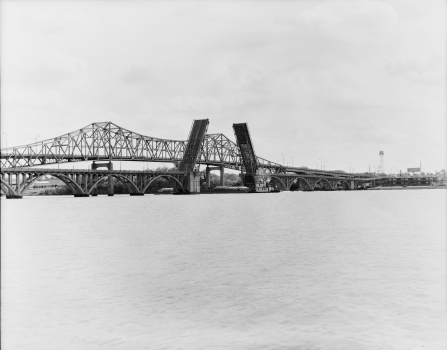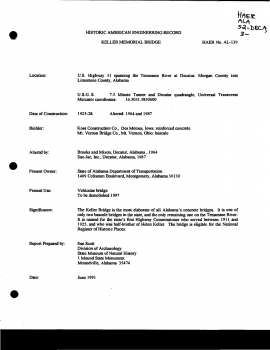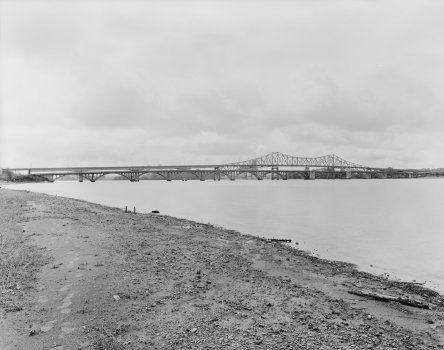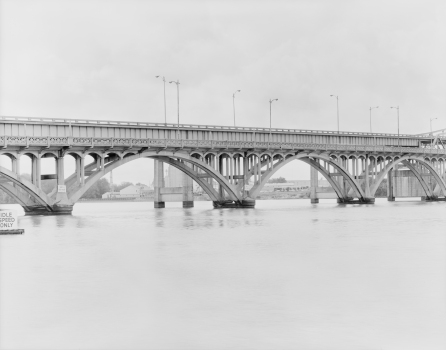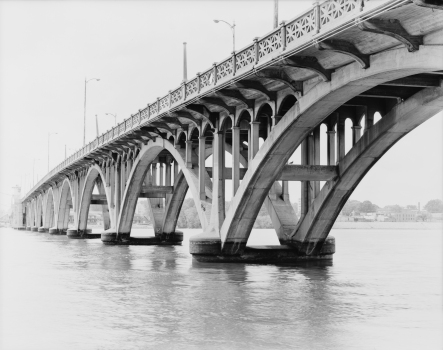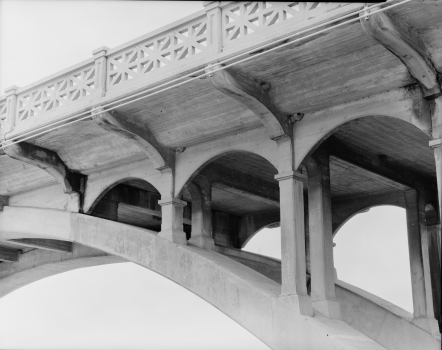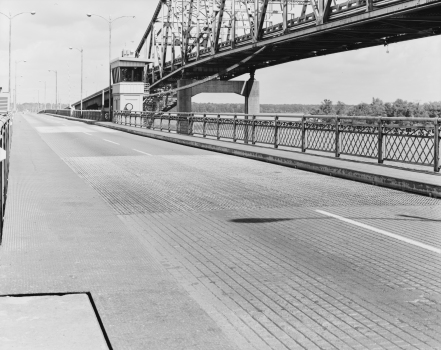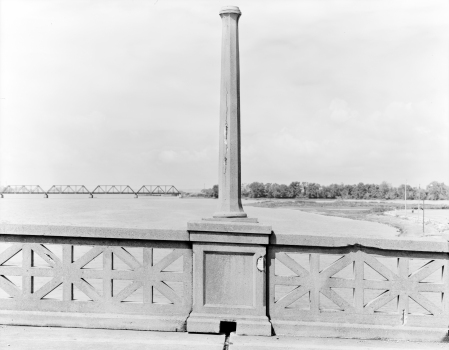General Information
Project Type
| Structure: |
Double-leaf bascule bridge |
|---|---|
| Function / usage: |
Road bridge |
| Structure: |
Deck arch bridge |
| Material: |
Reinforced concrete bridge |
| Plan view: |
Structurae Plus/Pro - Subscribe Now! |
Location
| Location: |
Decatur, Limestone County, Alabama, USA |
|---|---|
| Crossed: |
|
| Replaced by: |
Captain William J. Hudson "Steamboat Bill" Memorial Bridge (1963)
|
| Coordinates: | 34° 36' 48.09" N 86° 58' 21.05" W |
Technical Information
Materials
| arches |
reinforced concrete
|
|---|---|
| bascule span |
steel
|
| piers on arch |
reinforced concrete
|
Significance
The Keller Bridge is the most elaborate of all Alabama's concrete bridges. It is one of only two bascule bridges in the state, and the only remaining one on the Tennessee River. It is named for the state's first Highway Commissioner who served between 1911 and 1925, and who was half-brother of Helen Keller.
Description
The Keller Memorial Bridge carries U.S. Highway 31 across the Tennessee River from Decatur in Morgan County into Limestone County to the northeast (Figure 1). It is located at milepoint 360,53 (UTM coordinates (coordinates : latitude 34D 36.8, longitude 086D 58.4). Hie bridge is owned and maintained by the Alabama Highway Department, and is eligible for the National Register ofHistoric Places.
William Simpson Keller
William Simpson Keller was Alabama's first Highway Engineer, and a half-brother of Helen Keller. He was born 0 February 20, 1874, in Tuscumbia, Alabama. His mother died very young, and Helen was bom several years later after his father remarried. W.S. Keller attended undergraduate school at the State Normal College at Florence. In 1893 he graduated with a B.C.E. degree from the University of Alabama. He married Ailecn Walton Moore of Columbia, Tennessee, who died in 1912. In 1913 he married Abbie Search, the daughter of Dr. James Searcy. He worked as an engineer in Alabama and Tennessee for several state and federal institutions prior to his appointment as state Highway Engineer of Alabama in 1911. He helped to organize the Highway Department in 1911, and was active as director until his death in Montgomery in 1925. He died on September 9 of a lingering illness, perhaps cancer. His residence in Montgomery was at 306 Fclder Avenue, across from the Presbyterian Church where he was an elder. According to Helen Keller's niece, Mrs. Patty Johnson of Tuscumbia, the relationship between Helen and William Simpson was a close one, although correspondence between them has not been documented.
Keller was much esteemed during his life as a professional and as a warm and caring individual, and after his death for the contributions he made toward the development of North Alabama. He was elected as a member of the American Society of Civil Engineers on Jury 2, 1913. In 1939, his portrait was unveiled in the Highway Department Building, painted by Willie Gayle Martin of Shorter, Macon County, Alabama. His nickname was "Simp" (personal communication Michael Breedlove).
The text of the bronze commemorative plaque deserves quoting in full: "A native son in this Valley, First Chief Engineer of Alabama State Highway Department. One of America's pioneer road builders, a charter member and a president of The American Association of State Highway Officials, his personality, ability and character inspired to service, citizenship and manliness, and to him came the cooperation, honor and love of his associates. His vision and leadership laid the foundation for the highway system of Alabama, and this bridge is his realization of one of its most important links".
Despite its official name, the bridge is not "memorial" in the sense that others of its generation are. Fifteen memorial bridges, the Houston, the Bankhead, and the Comer, among others, were financed by a state legislative act in 1927, which enabled construction funds to be repaid by means of a toll. Eventually the unpopular toll was eliminated, The fifteen memorial bridges were named to commemorate "eminent deceased Alabamians" (Owen 1930:200). Keller was honored likewise by having a bridge named for him, but the bridge itself is not part of the state's "memorial bridge" system.
Description of the Keller Bridge
The Keller Bridge stretches 2077' across the Tennessee River. It is an arch deck, open spandel bridge with 18 approach spans. The main span, 212' is a movable bascule, or drawbridge, a nineteenth century design. The Keller Bridge is only one of two bascule bridges in the state (the other is Dog River near Mobile), and the only on the Tennessee River. Both are slated for demolition.
An early description of the design and structure of the bridge was given by State Highway Department Engineer H. H. Houk in a 1928 newspaper account on the day the bridge was inaugurated. The design is one of two considered by the Highway Department; the alternative is not discussed. It is noted that the arch design cost an extra $75,000, but the additional money was justified by the elegance of the design and the aesthetics of the structure in a lovely natural setting. However, money was not to be thrown away: "The details of the structure were proportioned and the grade of the roadway chosen with the idea of providing as graceful and distinctive a structure as possible without expenditure for excessive ornamentation".
Several companies were involved in construction. Koss Construction Co., Des Moines, Iowa, were contractors for the reinforced concrete portion of the bridge. Harrington, Howard and Ash of Kansas City, Missouri, were retained as consultants on the design of the movable span and machinery, while Mt. Vernon Bridge Co. of Mt. Vernon, Ohio, was contractor tor that portion. McWhorter and Gilbert were contractors for the Swan Creek Bridge and north approach fill. The south approach trestle and roadway approach were the responsibility of J. B. Turner.
F. H. Gardner, Jr. was resident engineer in the early stages of construction with H. F. O'Cain as assistant. J.L. Land replaced Gardner as resident engineer, and carried the job to completion with J. B. Carter as assistant and B. L. Bray and J. A. Haistip as inspectors. R. E. Taylor inspected the fabrication of the steel and machinery at the factories. J. B. Trotter, assistant bridge engineer C. B. Moore, locating engineer, Paul Moller, P. L. Andrews and Meilon Messer, designers, also participated in the design and construction work.
The original bridge consisted of 12 two-ribbed open spandrel reinforce concrete arches. The navigational channel flows underneath the bascule. Piers were placed 103 feet apart at the Decatur end of the bridge, and 124 feet apart at the center. Two massive solid concrete and steel piers support the bascule. Horizontal clearance on the navigation channel is 206 feet.
The width of the bridge is 20 feet (curb to curb), and the deck width is 30 feet (out to out). The median is open, with sidewalk width just under 4 feet (right 3.7, left 3.8). The deck structure is cast-in-place concrete with a gravel protective surface.
The History of the Keller Bridge
The bridge was built in response to local demand for modern industrial development during the early part of the 1900s. In 1912, WilliamS. Keller announced the commencement of construction of U.S. Highway 31. The community had to wait another fourteen years for the bridge to be built (Jenkins and Knox 1970:237). The near-by railroad bridge had been built in the late 1800s, but the Tennessee River would not give up its ferry service for vehicular traffic until the Keller Bridge was realized.
Private speculators attempted to gain a permit to build a bridge, which would turn a profit for them; but the State Highway Department stopped their negotiations, and authorized the construction of the Keller Bridge. Cost of the bridge over-ran the original estimate. State funds were supplemented by $50,000 respectively from Decatur and Albany, to be repaid by the Highway Department The debt was not settled for almost a decade. At that time the two towns had merged to become Decatur. The local historians go on to explain how the money was finally repaid, "In 1935, T. C. Almon, who was also City Attorney at this time, was elected to the legislature. In 1936, he succeeded in having the legislature pass an act refunding the $100,000 to Decatur. But he only succeeded in getting the money by a mandamus against the then Highway Director, Gaston Scott. But the money was repaid". The original cost was $468,000, shared by Decatur and Albany, the counties ofMorgan and Limestone, and the state highway commission. Construction was begun on September 17, 1925. The ground-breaking ceremony opened with selections by the Boys' Industrial Band followed by speeches by T. H. Alexander, representative of the governor of Tennessee, Congressman Eslick of the Seventh Tennessee District, and Alabama Governor, William W. Brandon.
The massive construction job took almost three years to complete. By late 1927 the local newspaper began to carry reports on the progress of construction almost every day. Obtaining right of way along Sixth Street arose as a last minute complication. The Director ofthe state Highway Department, Judge Woolsey Finnel, declared that no date for opening the bridge could be set until the right of way was clear (The Pecatur Pailv. 1928a). The obstacle, the Gardner lot, had been deeded by Morgan Land Co. by John B. Weakley of Birmingham (The Pecatur Daily. 1928b). Mr. Weakley apparently got word that he seemed to be holding up the inauguration date, and within a week had an open letter of explanation published in the newspaper. He had no intention of blocking the right of way, and would facilitate obtaining the Gardner lot by turning the property over to the state at its actual cost of $5,000 (The Pecatur Dairy. 1928d). The way was clear to set the date of opening, and in days leading up to the event, only celebration plans were discussed in the newspaper.
As part ofthe preliminary plans, the Crescent Amusement Co. ofNashville was to send cameraman Dcwey Mouson to take moving pictures of pedestrians on the bridge, which would then be shown at the Princess Theater (The Pecatur Daily. 1928eY It is not reported if this event took place.
On Sunday, February 12,1928, the bridge was opened to pedestrian traffic, and to general traffic by March 1. The newspaper went on to report that State Engineer H. H. Houk, "who has had much to do with the direction of the work," inspected the bridge prior to its opening
The Keller Bridge, 1964 to the present
The Keller Bridge served the community well from its inauguration until 1964 when major renovation was needed to lengthen the south approach by replacing 5 concrete and wood spans with concrete and steel. The work was carried out by Brooks and Mixon, a local construction company no longer in business. The cost of this work was $579,815, according to the state Highway Department
In 1961, the Tennessee River Bridge was built to relieve traffic of the two-lane Keller. The new bridge carries northbound traffic, leaving the southbound on the Keller.
In the late 1970s, the local newspaper began to recount a growing number of problems. In 1977, a barge collided with a pier, causing worries from the director of the County Civil Defense that cars idling on the bridge might be in danger if a pier were struck, causing the bridge to collapse. Apparently, several similar incidents of barges banging into the piers had chipped away concrete, but had not caused serious damage to the substructure.
In its fiftieth anniversary year, the Keller Memorial Bridge was recognized as obsolete, and in dire need of overhaul to its electrical system and gears. Navigational problems increased with the larger barges passing through the difficult channel between the railroad bridge and the Keller. The railroad bridge's swing span, built in 1885, was replaced in 1978, with a lift span, a renovation thought to ease barge passage. However, the 350-foot horizontal clearance of the Keller was still too narrow for the larger channel traffic (the passage misaligned between the railroad bridge and the Keller) and accidents continued to occur.
Another problem, reported in 1981, concerned boaters not being able to get the attention of the Keller drawbridge attendants to raise the bridge for their tall masted sailboats. The attendants' room was placed so that it was difficult to see small craft, and impossible to hear their shouts. Occasionally sailboat masts were damaged when boaters attempted to pass under the closed bascule.
By 1983, word had gone out that the Keller was to be replaced when funds would become available. The Decatur Daily (1983) quoted the long-time bridge tender, Coy Clem, that the bridge was mechanically safe, but problems were caused by traffic jams when the spans had to be raised. A greater number of increasingly larger barges required the bridge spans to be raised approximately 300 times per month. Area residents lost time from work and school as vehicular traffic was stopped for 15-20 minutes with each opening. It was not a problem that would go away.
The traffic tie-up was the major reason the highway Department gave the Keller an extremely low official sufficiency rating of 4, on a scale of 0 to 100 (worst to best). The two main components of the sufficiency rating are "functionally obsolete" and "structurally deficient." The bridge was considered safe even though it was more than 50 years old at the time of the assessment It was functionally obsolete because it was not designed for the heavier, larger vehicles and barges. Hie steady growth in vehicular traffic is seen in data from the State Highway Department: in 1982, 11,000 vehicles crossed each bridge daily; in 1985, the number had grown to 11,860. By 1988, the average daily traffic was 15,670 of which 7 percent was truck traffic. The low sufficiency rating made the bridge eligible for replacement, but the state Highway Department had other projects higher on the priority list Meanwhile solutions to the problem were sought. The mechanical apparatus for raising and lowering the spans continued to deteriorate, slowing the drawbridge, and causing further delays. A consulting firm, Diaz-Seckinger and Associates of Tampa Florida, was brought into assess the Keller's mechanical and electrical equipment.
Even more barge traffic was expected with the opening of the Tennessee-Tombigbee Waterway in 1985. A year prior to the opening, local voices of concern were again raised, and reported in The Decatur Daily (1984). It was estimated that the bridge would be opened 20 percent more often, once the Ten-Tom was in use. More frequent waits for the drawbridge worried area residents.
The Keller was closed for repairs on Monday, April 20, 1987. All traffic was shifted to the Tennessee River Bridge, which had been made two-way for the 90-day duration of reconstruction. Traffic congestion continued with the doubled number of vehicles.
The Decatur Daily described the renovations. A local company, Sue-Jac, Inc., was awarded the $1.04 million contract for renovations, including replacement of drive gears and electronic wiring, a new generator, and construction ofa bridge-tender's house. Darrell Sims served as project manager. New gears and wiring allowed the spans to be raised and lowered in seven minutes as opposed to the 40 minutes needed with the old and worn apparatus. A set of one 35-horsepower motor and 14 gears was placed underneath the base of each span. Gears range in size form size inches to four feet in diameter. Protective covers were used on the new gears to prevent weathering, and infrared heaters used in winter keep the gears from freezing.
Formally, electricity was carried through conduits in the Keller. The new system carries the current from nearby power poles, through conduits on the Tennessee River Bridge, and onto the Keller. The original "tractor engine" generator was replaced by a new General Electric 15,000 kilowatt generator which serves as a back-up to the new electrical system. The new bridge tender's house, described as the "nerve center" was relocated, providing clear visibility of the bridge and water traffic. Bathroom facilities, previously lacking, were included as part of the amenities. Sue-Jac subcontracted North Alabama Glass Co., Goss Electric Co., and W & S Electrical and Air Conditioning Co., for work on the bridge tender's house.
Sue-Jac completed renovations approximately two weeks before the July 19 deadline set in the contract. A five-day trial period, supervised by the State Highway Department, revealed no flaws in the construction work.
Renovations of the bridge in 1987 appear to have alleviated the problem of traffic jams, but by 1989 another potentially dangerous situation arose with runaway barges hitting the piers. The newspaper reported several such incidents (The Decatur Daily 1990). The Keller Bridge was not involved in all the accidents, but its misalignment with the other bridges and its narrow passage make it a part of the overall problem. Chunks of concrete were broken from the Keller's pier, but no serious structural damage was done. The major threat came from the potential of spilling hazardous chemicals into the waterway from the barges. To date, barges carrying chemicals have not hit the piers, but the possibility remains a concern for the populace. Replacement of the Keller appears to be the only solution to unsnarl traffic jams and avoid barge collisions. Highway officials estimated the cost of demolishing the Keller at $415,000.
Full Report of the Historic American Engineering Record by Sue Scott, June 1991, available bere
Excerpt from Wikipedia
Keller Memorial Bridge
The first bridge built here was the William Keller Bridge, completed in 1928. This drawbridge served as the primary until the cantilever truss bridge was built in 1963. The Keller Bridge carried the southbound traffic and the new bridge carried the northbound traffic. As time moved on, the currents of the Tennessee River changed and running barges through the narrow gap created by the drawbridge became more dangerous, and the bridge was hit several times by barges. Also, with the amount of traffic carried by the road, the drawbridge could produce mile long traffic jams. In 1999 the new concrete bridge opened. Northbound traffic was shifted to the new bridge, southbound was moved to the cantilever bridge, and the Keller Bridge was removed. There are additional pictures and information about the Keller Memorial Bridge available from the Historic American Engineering Record at the Library of Congress.
Text imported from Wikipedia article "Captain William J. Hudson %22Steamboat Bill%22 Memorial Bridges" and modified on 23 July 2019 under the CC-BY-SA 3.0 license.
Participants
- Koss Construction Company (concrete)
- Mt. Vernon Bridge Company (bascule span)
Relevant Web Sites
- About this
data sheet - Structure-ID
20050976 - Published on:
27/12/2009 - Last updated on:
27/10/2023

